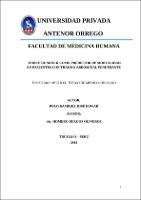Mostrar el registro sencillo del ítem
Índice de shock como predictor de mortalidad en pacientes con trauma abdominal penetrante
| dc.contributor.advisor | Homero Burgos, Oliveros | |
| dc.contributor.author | Polo Ramirez, José Edwar | |
| dc.creator | Polo Ramirez, José Edwar | |
| dc.date.accessioned | 2014-11-26T17:17:46Z | |
| dc.date.available | 2014-11-26T17:17:46Z | |
| dc.date.issued | 2014 | |
| dc.identifier.uri | https://hdl.handle.net/20.500.12759/534 | |
| dc.description.abstract | Determinar si el Índice de shock a la admisión es un predictor de mortalidad en pacientes con trauma abdominal penetrante en el Hospital Regional Docente de Trujillo. MATERIAL Y MÉTODO: Se realizó un estudio observacional, analítico, de casos y controles anidados, que evaluó 144 pacientes, los cuales fueron distribuidos en dos grupos: Grupo I: 16 pacientes que fallecieron y Grupo II: 128 pacientes que sobrevivieron. RESULTADOS: La edad promedio para el grupo I fue 27,44 ± 6,49 años y para el grupo II fue 24,93 ± 5,51 años; el 87,5% de los pacientes correspondieron al sexo masculino en el grupo I y en el grupo II 98,44%; el tipo de arma utilizada más frecuente fue el proyectil por arma de fuego en 100% y 92,19% en el grupo I y II respectivamente. En lo que respecta al índice de shock categorizado a un punto de corte de 0,7, el 100% de los fallecidos tuvo un valor por encima de > 0,7 y en el grupo de pacientes que sobrevivieron el 74,23% de los pacientes tuvo un valor por encima de este punto de corte (p < 0,05); la sensibilidad, especificidad, VPP y VPN fueron 100%, 25,78%, 14,41% y 100% respectivamente; siendo el rendimiento diagnóstico global del índice de shock en predecir mortalidad del 89,01%. CONCLUSIONES: El índice de shock mostró un rendimiento diagnostico en predecir mortalidad en pacientes con trauma abdominal penetrante del 90%. | es_PE |
| dc.description.abstract | To determine whether the shock index admission is a predictor of mortality in patients with penetrating abdominal trauma in Trujillo Regional Teaching Hospital. MATERIAL AND METHODS: We conducted an observational, analytical, nested case-controls study that evaluated 144 patients, which were divided into two groups: Group I: 16 patients who died and Group II: 128 patients who survived. RESULTS: The mean age of group I was 27.44 ± 6.49 years and for group II was 24.93 ± 5.51 years; the 87.5% of patients were male in the group I and group II 98.44%; the type of weapon used was the most common firearm projectile at 100% and 92.19% in group I and II respectively. With respect to the shock index categorized to a cutoff of 0.7, 100% of those who died had a higher value of > 0.7 and in the group of patients who survived the 74.23% of the patients had a value above this cutoff (p < 0.05); the sensitivity, specificity, PPV and NPV were 100%, 25.78%, 14.41% and 100% respectively; with an overall diagnostic yield of shock index in predicting mortality of 89.01%.. CONCLUSIONS: The index showed shock performance diagnosis predicts mortality in patients with penetrating abdominal trauma 90% | en_US |
| dc.description.uri | Tesis | es_PE |
| dc.format | application/pdf | es_PE |
| dc.language.iso | spa | es_PE |
| dc.publisher | Universidad Privada Antenor Orrego | es_PE |
| dc.rights | info:eu-repo/semantics/openAccess | es_PE |
| dc.rights.uri | https://creativecommons.org/licenses/by/4.0/ | es_PE |
| dc.source | Universidad Privada Antenor Orrego | es_PE |
| dc.source | Repositorio Institucional - UPAO | es_PE |
| dc.subject | Índice shock | es_PE |
| dc.subject | Trauma abdominal | es_PE |
| dc.title | Índice de shock como predictor de mortalidad en pacientes con trauma abdominal penetrante | es_PE |
| dc.type | info:eu-repo/semantics/bachelorThesis | es_PE |
| thesis.degree.level | Título Profesional | es_PE |
| thesis.degree.grantor | Universidad Privada Antenor Orrego. Facultad de Medicina Humana | es_PE |
| thesis.degree.name | Médico Cirujano | es_PE |
| thesis.degree.discipline | Medicina Humana | es_PE |
| dc.subject.ocde | https://purl.org/pe-repo/ocde/ford#3.02.27 | es_PE |
| renati.type | https://purl.org/pe-repo/renati/type#tesis | es_PE |
| renati.level | https://purl.org/pe-repo/renati/level#tituloProfesional | es_PE |
| renati.discipline | 912016 | es_PE |
| dc.publisher.country | PE | es_PE |
Ficheros en el ítem
Este ítem aparece en la(s) siguiente(s) colección(es)
-
Medicina Humana [2969]


